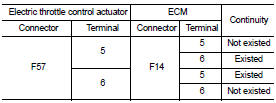Nissan Altima (L32) 2007-2012 Service Manual: P2101 electric throttle control function
Description
Electric throttle control actuator consists of throttle control motor, throttle position sensor, etc.
The throttle control motor is operated by the ECM and it opens and closes the throttle valve.
The current opening angle of the throttle valve is detected by the throttle position sensor and it provides feedback to the ECM to control the throttle control motor to make the throttle valve opening angle properly in response to driving condition.
DTC Logic
DTC DETECTION LOGIC
NOTE: If DTC P2101 is displayed with DTC P2100 or P2119, first perform the trouble diagnosis for DTC P2100 or P2119. Refer to EC-417, "DTC Logic" or EC-425, "DTC Logic".

DTC CONFIRMATION PROCEDURE
1.PRECONDITIONING
If DTC Confirmation Procedure has been previously conducted, always turn ignition switch OFF and wait at least 10 seconds before conducting the next test.
TESTING CONDITION: Before performing the following procedure, confirm that battery voltage is more than 11V when engine is running.
>> GO TO 2.
2.PERFORM DTC CONFIRMATION PROCEDURE
1. Turn ignition switch ON and wait at least 2 seconds.
2. Start engine and let it idle for 5 seconds.
3. Check DTC.
Is DTC detected? YES >> Go to EC-419, "Diagnosis Procedure".
NO >> INSPECTION END
Diagnosis Procedure
1.CHECK GROUND CONNECTION
1. Turn ignition switch OFF.
2. Check ground connection E9. Refer to Ground Inspection in GI-45, "Circuit Inspection".
Is the inspection result normal? YES >> GO TO 2.
NO >> Repair or replace ground connection.
2.CHECK THROTTLE CONTROL MOTOR RELAY INPUT SIGNAL CIRCUIT-I
Check the voltage between ECM harness connector and ground.


Is the inspection result normal? YES >> GO TO 7.
NO >> GO TO 3.
3.CHECK THROTTLE CONTROL MOTOR RELAY POWER SUPPLY CIRCUIT
1. Disconnect ECM harness connector.
2. Disconnect IPDM E/R harness connector F10.
3. Check the continuity between ECM harness connector and IPDM E/R harness connector.

4. Also check harness for short to ground and short to power.
Is the inspection result normal? YES >> GO TO 4.
NO >> Repair open circuit or short to ground or short to power in harness or connectors.
4.CHECK THROTTLE CONTROL MOTOR RELAY INPUT SIGNAL CIRCUIT-II
1. Check the continuity between ECM harness connector and IPDM E/R harness connector.

2. Also check harness for short to ground and short to power.
Is the inspection result normal? YES >> GO TO 5.
NO >> Repair open circuit or short to ground or short to power in harness or connectors.
5.CHECK FUSE
1. Disconnect 15A fuse (No. 42) from IPDM E/R.
2. Check 15A fuse for blown.
Is the inspection result normal? YES >> GO TO 6.
NO >> Replace 15A fuse.
6.CHECK INTERMITTENT INCIDENT
Refer to GI-42, "Intermittent Incident".
Is the inspection result normal? YES >> Replace IPDM E/R.
NO >> Repair or replace harness or connectors.
7.CHECK THROTTLE CONTROL MOTOR OUTPUT SIGNAL CIRCUIT FOR OPEN OR SHORT
1. Turn ignition switch OFF.
2. Disconnect electric throttle control actuator harness connector.
3. Disconnect ECM harness connector.
4. Check the continuity between electric throttle control actuator harness connector and ECM harness connector.

5. Also check harness for short to ground and short to power.
Is the inspection result normal? YES >> GO TO 8.
NO >> Repair or replace.
8.CHECK ELECTRIC THROTTLE CONTROL ACTUATOR VISUALLY
1. Remove the intake air duct.
2. Check if foreign matter is caught between the throttle valve (1) and the housing.
2. Electric throttle control actuator


Is the inspection result normal? YES >> GO TO 9.
NO >> Remove the foreign matter and clean the electric throttle control actuator inside.
9.CHECK THROTTLE CONTROL MOTOR
Refer to EC-421, "Component Inspection".
Is the inspection result normal? YES >> GO TO 10.
NO >> GO TO 11.
10.CHECK INTERMITTENT INCIDENT
Refer to GI-42, "Intermittent Incident".
Is the inspection result normal? YES >> GO TO 11.
NO >> Repair or replace harness or connectors.
11.REPLACE ELECTRIC THROTTLE CONTROL ACTUATOR
1. Replace malfunction electric throttle control actuator.
2. Go to EC-422, "Special Repair Requirement".
>> INSPECTION END
Component Inspection
1.CHECK THROTTLE CONTROL MOTOR
1. Disconnect electric throttle control actuator harness connector.
2. Check resistance between electric throttle control actuator terminals as follows.


Is the inspection result normal? YES >> INSPECTION END
NO >> GO TO 2.
2.REPLACE ELECTRIC THROTTLE CONTROL ACTUATOR
1. Replace electric throttle control actuator.
2. Go to EC-422, "Special Repair Requirement".
>> INSPECTION END
Special Repair Requirement
1.PERFORM THROTTLE VALVE CLOSED POSITION LEARNING
Refer to EC-29, "THROTTLE VALVE CLOSED POSITION LEARNING : Special Repair Requirement" >> GO TO 2.
2.PERFORM IDLE AIR VOLUME LEARNING
Refer to EC-30, "IDLE AIR VOLUME LEARNING : Special Repair Requirement" >> END

 P2100, P2103 throttle control motor
relay
P2100, P2103 throttle control motor
relay P2118 throttle control motor
P2118 throttle control motor